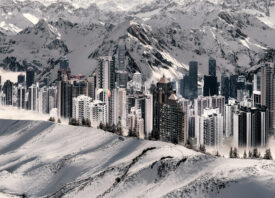Search this site
Announcing the Winners of the Feature Shoot Reader Spotlight (January)

We’re thrilled to announce Andreas Kremer, Marcus Peel, and Lisa Levine, as the winners of Feature Shoot’s Reader Spotlight for the month of January. Every month, we invite photographers to submit their best bodies of work, with three chosen to be featured in both our regular and special edition newsletters, going out to an estimated 80,000 people overall, including gallerists, publishers, editors, agents, and more. The three winners–Peel, Levine, and Kremer–will also be featured across our social media channels.
While different in subject matter and approach, this month’s winners all speak to the idea of home, place, and belonging–a theme that feels especially resonant following months of isolation and our current exploration of the virtual world beyond our physical reality.

Marcus Peel‘s subtle yet evocative series Dens is a study in the art of forest den-building. “Each den is unique in design yet similar in construction, usually consisting of an upside-down cone shape, similar to a tipi, using a number of long branches as the frame coming together at the top and spreading out at the bottom,” the artist explains.
“At times, attempting to document the dens proved frustrating, as I would return to one that I wanted to photograph only to find it had been broken down. Frustration, however, quickly gave way to excitement; I was racing against the clock to capture these fleeting designs, and my photographs would be the only lasting record of them.” At a time when our connection to the natural world feels increasingly precarious, Peel’s work serves as a reminder of both its grace and fragility.

Lisa Levine blurs the boundary line between reality and the imagination in her series Virtually No Place Like Home, an exploration of the meaning of home, classic Americana, and truth in the age of digital manipulation. “Everything that is presented in these images existed in the observable world but not necessarily in the location or form in which I present them,” she admits.
“During the months of ‘sheltering in place,’ this series has taken on new meaning for me. These solitary houses speak of physical and social isolation; both the safety and comfort and the loneliness and exile of home. There’s a new sense of urgency in using the home’s exterior to signal to others information about who lives within these walls and what is important to them.”

Andreas Kremer further explores our tenuous relationship with the natural world in The Last Resort, a series of dystopian images depicting landscapes and urban spaces straight from a science-fiction novel. “Since its early days, artistic collage has been widely used to point out social or political grievances,” he says. “Based on this tradition, I use it to create a dissonance between architecture, landscape, and culture, like a proposal for a more or less ‘fantastic,’ temporally and spatially compressed, pictorial ‘reality.’
“In deceptive harmony, the resulting monumental visions present a closed, possibly existing world and leave the question of anticipated future or presence unanswered. They might stimulate reflection on the way we think of the world and our place in it today.”



